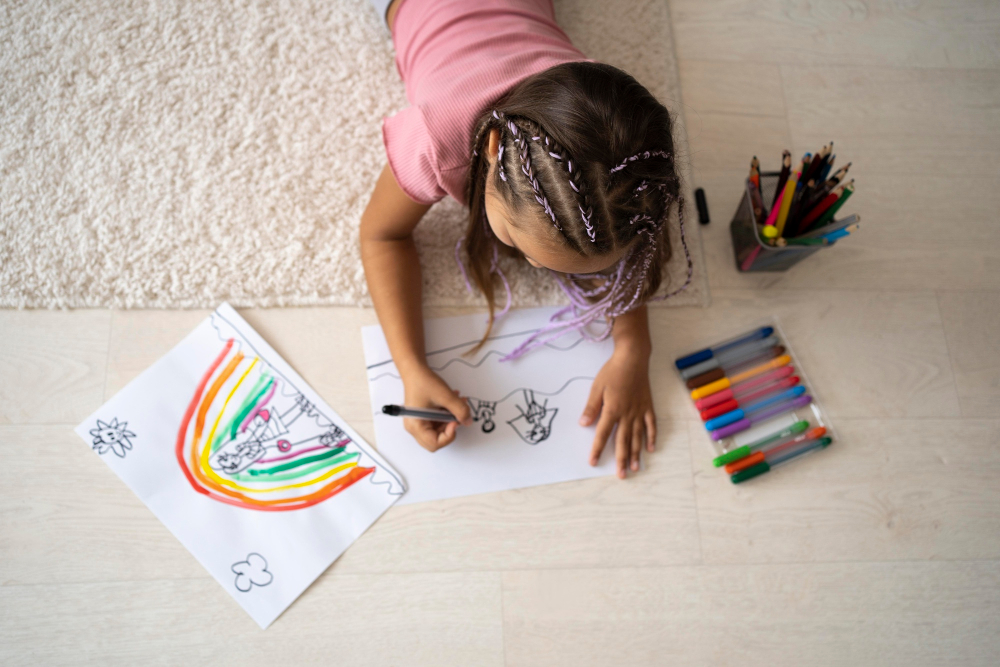15 January 2025
7 min.
Have you ever watched a child lost in a world of their own drawings? When pencil touches paper, time pauses and pure imagination takes flight. This is a wonderful moment for a parent to witness and a valuable part of a child's creative growth.
Through free drawing and other creative arts, a child can experience a kind of learning where there are no rules or limits. A kid's art kit can be a portal to the realm of imagination. There, they can explore their own emotions, build problem-solving skills and find new ways to express themselves. In this blog, we will delve into the benefits of free drawing and children's art supplies for a child's imagination. We'll explore how kid's craft kits help emotional expression, cognitive ability, and language skills. We'll also suggest some activities you can try at home.

First and foremost, children’s art supplies will help a child and encourages creative development. The importance of creative expression for a child’s growth cannot be overstated and free drawing is a great way to get your child creating.
Creativity is not just about making art; it’s about thinking differently and exploring possibilities. This is exactly what children’s art supplies help your child to do. When children draw freely, they aren’t just creating pictures—they’re creating ideas.
Every time a child sits down with their kid’s craft kit, they create entire worlds inside their head. They imagine different characters, settings and scenes, then they experiment with reality. A child might create a castle in the sky or a robot that makes breakfast. These imaginative leaps teach them to combine unrelated ideas in novel ways.
This fosters what psychologists call divergent thinking. Divergent thinking benefits not just creativity and artistry in adulthood, but innovation and problem-solving too.
You might have guessed that children’s art supplies encourage creativity, but did you know they can help a child learn to think critically as well? That’s right, craft kits for kids can have huge benefits for a child problem-solving ability too!
Art naturally presents challenges. These challenges could be deciding how to draw abstract ideas like love or something as simple as running out of space on the page. In either case, working around these issues requires critical thought and creative problem-solving.
What happens when a child faces these challenges is that they are pushed to consider multiple solutions, balance them against each other, and choose the one they think will work best. This kind of creative dilemma encourages a child to approach challenges from more than one angle. This helps a child to build adaptability and resourcefulness – qualities that will be invaluable in all walks of life.
Strange as it seems, free drawing strengthens verbal communication too. In fact, drawing is particularly helpful for children who are still learning to speak. Craft kits for kids at this age can really help the transition from non-verbal to verbal communication.
For example, a kid’s craft kit like the Letters and Numbers Tracing is a stencil set that helps improve toddler’s language skills. This then helps them to draw and describe what they’ve drawn to grownups and solidify their language development.
For slightly older children, when describing their drawings to parents they can practice putting words to their most imaginative ideas. They connect words and concepts to articulate themselves, and in doing so expand their vocabulary. This is not only beneficial for your child’s storytelling ability, but it can also help to develop their emotional expression.

Many young children find it hard to express themselves emotionally. Often, this is not because they don’t want to, but because they lack the vocabulary and skills to do so. Drawing provides another means of expression helping to fill in these gaps in their abilities.
Far more than just creating images, free drawing is an avenue for children to explore feelings through visual narratives. Scenes of family or nature might express feelings of joy and security. More turbulent images could indicate anxiety or confusion.
Through this visual expression, children develop a better understanding of their emotions. They enhance their emotional literacy which can help them speak about their feelings more lucidly later on in their life. Kid’s craft kits can offer parents important insights into their child’s mind too.
This aspect of children’s art supplies not only aids in emotional self-expression but also fosters emotional intelligence. This means it helps children relate to others as well as understand themselves better. That’s why free drawing and children’s art supplies are such a useful tool in teaching your child kindness and sociability.
Craft kits for kids are for more than just fun; they’re for growth and development. Unfortunately, encouraging artistic expression is not as simple as sitting your child down in front of a kid’s easel. That’s why it’s a great idea to plan creative activities and projects that you and your child can do together.
Here are a few of our favourite ideas to get you inspired:
Craft kits for kids can teach so much more than artistic expression. Children learn to express emotions, think creatively, and solve problems in innovative ways. Each stroke of colour and line drawn is a step towards developing their unique voice and perspective.
The skills gained through free drawing – be it in narrating a story, depicting complex emotions, or experimenting with different forms – are invaluable assets that children carry with them into adulthood.
A kid’s craft kit empowers a child to explore, imagine, and grow in a world that values creativity and expression. So, let’s provide the canvas, the colours, and the freedom for our young artists to flourish, as they paint their paths to a bright and imaginative future.
